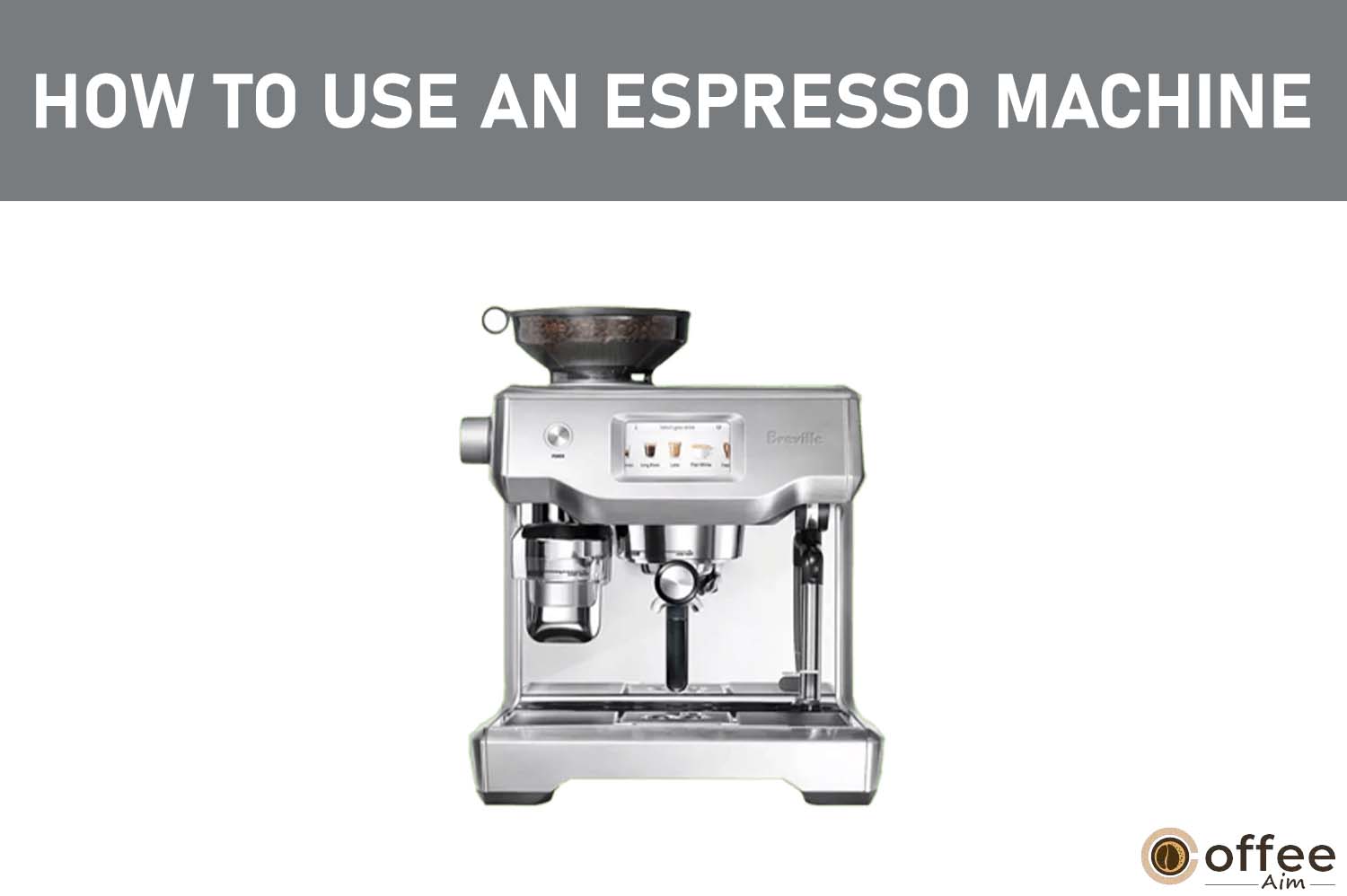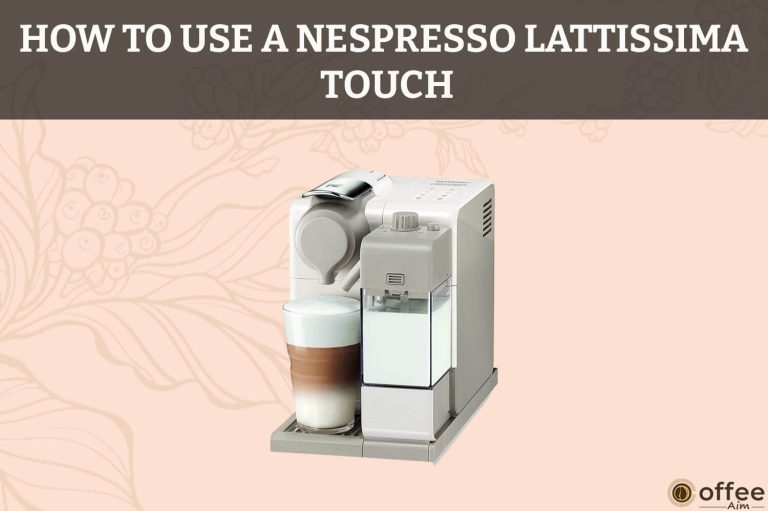
Quick Navigation
This guide is designed to help you learn the basics of using an espresso machine. It includes the necessary information you need to know to use your espresso machine and make delicious espresso and coffee.
Coffee Aim Recommends Safety First
At Coffee Aim, we are very much aware of safety. We only advise you to choose espresso machines or coffee makers manufactured by the manufacturer keeping in mind the safety of the consumers. Our valued readers are first and foremost in our minds. In addition, we recommend that you exercise caution when using any brand of espresso machine or brewer and follow the following precautions.
Necessary Safeguards While Using An Espresso Machine
Whether you are a new user of a single-serve coffee maker, an espresso machine, or a grind and brew coffee maker or have been using it for ten years, read all the instructions below and save them. And consider these safeguards before using your espresso machine:
- Whether you’re using a coffee maker, drip coffee maker, Keurig, or Nespresso espresso brewer, don’t touch the hot surfaces of your appliances.
- Use handles or knobs of the coffee maker as advised in the instruction book of your espresso machine.
- Do not immerse electrical wires, plugs, or your espresso machine in water or other liquids to protect against electric shocks, fires, and injuries.
- Close monitoring is essential when using your espresso machine close to children.
- Do not allow children to use your brewer without your supervision.
- If your espresso machine is to be: – stored – assembled – moved – cleaned, or – left unattended, always turn off the device by pressing the power button and unplugging it from the power outlet.
- Unplug the espresso maker from the outlet before cleaning and when not in use.
- Allow your espresso machine to cool before installing or removing parts and before cleaning.
- We recommend inspecting your espresso machine and power cord regularly.
- Do not use the espresso machine if its power cord or plug is damaged or it is malfunctioned or damaged in any way. Stop using it immediately and call your espresso machine consumer support.
- Please do not use the accessory attachments that your espresso machine manufacturer does not recommend; it may result in fire, electric shock, or injury.
- Do not allow your device’s power cord to hang over the countertop or table edge or touch fire or hot surfaces.
- Do not place your espresso machine near the countertop or table edge. Ensure the surface you are installing the machine on is leveled, clean, and free of water and other substances.
- Do not place your espresso machine on or near a hot electric or gas burner. Please do not allow it to contact the hot oven or keep it in it.
- If your espresso machine is recommended for home use, only use it. Do not use your espresso machine for anything other than the intended use. If your espresso machine is for household use only, avoid using it outdoors; avoid using it in moving vehicles or boats.
What is the Purpose of Memory Storage Chips in Espresso Machines
Please note that some manufacturers like Breville and DeLonghi imbed internal memory storage into your espresso machine to serve their customers better. It is a small memory storage chip that collects certain information about your espresso machine, including the frequency of use of the machine and how your machine is being used. If your espresso machine is returned for service, the manufacturer collects the information from the chip that enables the manufacturer to quickly and efficiently service your machine. This collected information also serves as a valuable resource in developing future espresso machines to serve the needs of their consumers better. The memory chips do not collect any information regarding the individuals who use the coffee machine or the household where the machine is used. Having a question regarding the memory storage chip, please get in touch with your appliance manufacturer.
Related: Nespresso Descaling Solution Review →
Specific Instructions For Your Espresso Machine
- We recommend installing your espresso machine separately from other electrical appliances, properly grounded, and with a dedicated circuit.
- Do not touch moving parts.
- Before using it, your machine’s bean hopper is free of anything other than coffee beans.
- Use only cold water in your coffee machine’s water reservoirs. Avoid using liquids other than water. Avoid using too much filtered, demineralized, or distilled water as it can affect the taste of coffee and the way the espresso maker works.
- Before extracting, ensure the portafilter is firmly inserted into the group head and secured. And never remove the portafilter during the extraction process. Warning: To avoid the risk of injury, avoid opening the brew chamber during the brewing process.
- If your espresso machine has an auto-purge function, be careful after milk texturing because when the steam rod is lowered, the auto-cleaning function will purge the hot steam.
- Be careful when descaling as hot steam may escape. Before descaling, please turn off your coffee maker and allow it to cool for at least 1 hour, and ensure the drip tray is empty and fully inserted into the machine. For your coffee appliance’s instructions, go to Espresso Machine Repair and Maintenance Page.
- Avoid trying to open or service your coffee machine yourself. If your machine is in the warranty period, call your machine manufacturer or call an experienced espresso machine technician.
- Call your machine’s Consumer Support for any maintenance other than cleaning; for assistance, visit our page Espresso Machine Repair and Services Near You.
How to Use the Water Filter of Your Espresso Machine?
- Keep filter cartridges out of reach of children.
- The filter cartridges should be stored in a dry place in the original packaging.
- The cartridges should be protected from heat and direct sunlight.
- Avoid using damaged filter cartridges.
- Avoid opening filter cartridges.
- If you are absent for a long time, empty the water reservoir and replace the cartridge.
Espresso Machine Instructions for Household Use Only
Most espresso machines use a small power cord to minimize personal injury or property damage due to pulling, tripping, or tangling a long cord. If you are sure that care is exercised in your house, you can purchase a longer detachable power cord or extension cord.
If you want to use an extension cord, you must follow:
- The marked electrical rating of the cord set or extension cord should be as good as the electrical rating of your espresso machine, grinder or milk cafe, or the device you are using this cord for.
- Arrange the cord to not wrap around the countertop or table where children can pull it or slip it unintentionally.
- A 3-prong grounding plug must be included with the extension cord.
How To Pull The Perfect Espresso Shot?
Brewing espresso is best done by hand, but not pod espresso because it is easy for lazy people and lame.
Things like baking bread and running a stick shift are better when done by hand, and espresso is one. Pod espresso is easy (and lame), And you can get it from your neighborhood coffee shop easily in-n-out in minutes, but for the cost of $4 per cup. But espresso brewing at your home comfort offers the pinnacle of connection to your brew.
When it comes to pulling a great shot of espresso, it is not as easy as A, B, and C; you have to go through much of the painful learning curve, but with the following tips, you can skip.
What You Need
- A Manual espresso maker or a semi-automatic espresso machine
- A burr grinder if your machine did not have an integrated grinder
- Tamper
- Freshly ground espresso beans, otherwise pre-ground
- A kitchen scale (optional)
- Milk thermometer
- Milk Frother if your machine did not have a built-in frother
At a Glance
| Features | Specs |
| Brew Time | 5 minutes |
| Yield | 2 cups |
Coffee Scale Importance in Brewing Espresso
Consistency is the key to making good espresso. Measuring with a cup or tablespoon is a good option if you want to make good espresso without weighing your coffee, but only if you know how much you are using each time. When dialing in your first shot, it is good to use a scale for the water to coffee ratio.
Can I Use Pre-Ground Coffee?
Regarding pre-ground coffee, know that you are limiting your beverage capacity; however, it is entirely possible to make espresso from pre-ground beans.
Want the best possible cup of espresso? You’ll be better off grinding it right before you brew it.
Making espresso is an art and a science. The perfect espresso is made with finely ground coffee, perfectly tamped down, and hot water that is forced through the grounds at just the right pressure. That’s why a good espresso machine is so important. It gives you the control you need to produce a consistently delicious cup of coffee.
To get started, grind your coffee beans to a fine powder. It’s important to use fresh beans that have been roasted within the past week or two. Then, put the grounds into the espresso machine’s filter basket and tamp them down firmly. Next, place a cup under the espresso machine’s nozzle and turn on the machine.
Once it’s heated up, press the button to start the flow of coffee. You’ll want to start with a small amount of coffee and then gradually increase the flow until you have about one ounce of espresso in your cup. If the espresso is too strong, add more water or decrease the temperature; if it’s too weak, add more grounds or increase the temp.
The perfect cup of espresso should be rich and full-bodied, with a thick crema on top. With a little practice, you’ll be able to make espresso like a pro.
Kris Silvey
Owner/Writer at ElevatedCoffeeBrew
Easy Steps: How To Use An Espresso Machine
Don’t worry; even if you don’t have the skills and the right tools to take a great shot of espresso, we are here to guide you. To get acquainted with the basics of espresso, first watch this fantastic video about espresso:
Now, follow the easy instructions below.
- Turn On Your Espresso Maker And Preheat It
It depends on your espresso machine how long it heats up, but to get the most out of your coffee maker, you need to make sure the whole machine is already warm. High-end machines like Breville and DeLonghi take a few seconds to warm up, while average quality machines can heat up to 25 minutes. So for a good espresso shot, it is important to preheat your machine!
PRO TIP – Some home baristas take a blank shot without filling the ground in the portafilter to speed up the preheating process. It warms up the machine quickly, but I don’t think it’s better. Because on the one hand you have to do a little bit of double duty and on the other hand it is out of the ordinary.
2. Measure And Grind Your Beans

If your espresso machine has a built-in grinder, set it to an espresso grind size, and if your machine is without a grinder, use the same practice for a separate burr grinder. If you have a blade grinder that doesn’t grind evenly, don’t worry about it right now because how to grind the perfect espresso size with a blade grinder, we’ll get back to that.
Place your portafilter on your kitchen scale and weigh it, then fill your portafilter with as many grams of ground coffee as the amount listed on your portafilter. The Breville Barista Express I use today has a 54mm portafilter. I fill it with 7 grams of ground coffee for a single shot, 14 grams for a double shot, and 18 grams for full flavor. But since my machine is equipped with a built-in grinder, I only set the program, and the machine does the rest.
Fill the ground coffee in your machine’s portafilter according to the capacity recommended by the manufacturer. It is advisable to work within their limits as some portafilters are larger or smaller than others, so they also take the amount of ground coffee according to their size.
When you fill your machine’s portafilter, you will initially feel a small mountain of ground coffee in the portafilter basket. Using your pink fingers, remove the excess coffee, and push it into the nooks and crannies to smooth it out so you can begin the pressure phase with your temper.
3. Tamp Your Grounds In The Portafilter

Before tamping, it is best to distribute your ground coffee roughly evenly throughout the portafilter basket.
All super-automatic and semi-automatic espresso machines that come with a built-in grinder temp themselves after grinding the beans. But if you have a manual espresso machine, you have to do the tamping yourself. You will need a good temper for this purpose.
The best way to tempt is to press straight down – your uneven puck will result in a bad espresso shot. You can apply some pressure here, although the old wisdom of 30lbs pressure is probably too much.
Be sure to keep the pressure on while tapping, neither too little nor too much.
To polish the top of your espresso puck, rotate your tweezers sharply and clean off any excess base sticking to the top or side of your portafilter.
The straight temp will ensure that the coffee is evenly spaced. And when the portafilter is pretty smooth in the basket, it will help you avoid channeling, i.e. prevent up, down, or contradictory extraction.
Now you are ready to brew.
- Pull Your First Shot
You are now going to pull this shot. Maybe your shot is 2 ounces because 2 ounces is the average size of a double shot of espresso. Estimate how long it will take you to take a 2-ounce shot. Ideally, your shot would take no more than 20-30 seconds.
If you are in the same range as I mentioned above, your job is technically done; you have made a good espresso.
I hope it’s probably rich, thick, dark, sweet, and wonderful. But, the fact is that this first shot is just a baseline; you have a lot for your next shots.
- How to Dial-In The Shot
Most semi-automatic and manual espresso machines have pressure gauges, which measure the pressure forced through the espresso. If this is the case in your machine, note the pressure reached. So if there is too much or too little pressure on your machine, you can adjust it for your next espresso shot. All good quality espresso machines like Breville BBino or BBino Plus always indicate how well (or poorly) your shot was extracted.
If your machine is without a pressure gauge, note the pull time in your book, taste your espresso, and make up your mind. If your machine has pulled the espresso shot too quickly, you should change to a finer grind. Conversely, you should change to a coarser grind if your machine has taken more time to pull your shot.
In the same way, you should change to a finer grind if your espresso tastes under-extracted (sour). On the other hand, if your espresso is bitter, it is under-extracted; it indicates that you should select a coarser grind.
You should dispose of your used coffee grounds properly and use a good knock box for them; it is eco-friendly.
If you are a lover of Italian espresso, your job is finished; enjoy your espresso; it is Italian, or if you are a latte lover and want to turn it into a milk-based coffee, keep reading.
Now, it’s time to convert espresso into a latte.
All you want to know is in the below video:
- Steam Your Milk
If you want to make latte, macchiato, latte macchiato, or cortado, the next step is to steam the milk. If you have Mr. Coffee or Smeg, your machine must have a steam wand. But if you have La Pavoni, Elektra S1, or Flair Espresso Maker, you will need to buy a separate milk steamer to froth your milk.
The Jura Z8 and Saeco Incanto come with an auto-purge system, but remove any stickiness that may have accumulated in the rod if your machine doesn’t have an auto-purge. To do this, turn on your steamer rod, which will remove the odor of milk from the inside of the rod, and clean the steam wand.
Now insert the tip of your machine’s steam rod into the cold milk poured into your stainless steel milk jug. Now turn on your steamer and stir the milk until it reaches your desired consistency. During the milk texturing process, make sure that the tip of the steamer stick is hidden just below the surface of the milk.

When the milk reaches the foam of your choice, keep your steaming stick dipped in the milk and keep steaming until the milk reaches your desired temperature. Clean the steam stick from the bottom with a towel or handkerchief and make it a habit to keep things clean.
Heat plays a crucial role in foaming milk. Too little heat will not foam your milk, and too much heat will burn your milk and give it an unpleasant taste. Practice, practice, practice, and you will feel like winning. And you will realize that you are now a good home barista.
Final Thoughts
If you want a rich, creamy, and flavorful espresso, bring some patience and a learning mindset to your espresso brewing adventure. It won’t take long for you to master it. Once you’ve mastered the art of espresso, other ways to make regular coffee will be easier for you.
FAQs
How Do You Make Regular Coffee With An Espresso Machine?
Espresso and coffee are two completely different beverages
You can’t make a regular cup of coffee with an espresso machine or an espresso with a coffee maker. Yes, if you have a dual-purpose machine that makes espresso and coffee, this is possible. Another popular way is to make your espresso as usual and then add hot water to it until you reach the desired amount. It will be Americano.
Can You Use Regular Coffee Beans In An Espresso Machine?
If your espresso beans have run out, you can use best coffee beans for espresso in your espresso machine. Espresso beans are specially formulated for low acidity, while regular coffee beans are formulated for more extraction methods. There is a big difference between the two. If you make espresso from regular coffee beans, their acidity will be harder to control. As a result, the espresso may become sour.
How Do I Make A Single Shot Of Espresso?
- Grind your whole coffee beans.
- Fill the required quantity of ground coffee in the portafilter.
- Tap the ground coffee with a tamper.
- Fix the portafilter in the group head of your espresso machine.
- And pull your espresso shot.
- Watch the video below for more information.
Can I Make Espresso Without A Machine?
Yes, it is possible. You can make espresso without an espresso machine, but we will not recommend it because the pressure required to make a good espresso can only be obtained from a good espresso machine. Therefore, you cannot make good espresso without an espresso machine.






